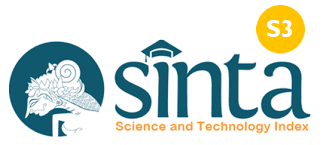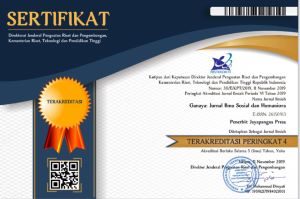Kemampuan Guru Mata Pelajaran Agama Hindu dalam Menjalankan Tugas Pembelajaran di Sekolah Dasar (Studi Kasus Sekolah Dasar Negeri di Kabupaten Karanganyar)
Abstract
This study aims to find out about the ability of Hindus subject teachers in compiling syllabus subjects in Elementary Schools in Karanganyar District, implementing Hinduism subject learning in Karanganyar Regency, students' responses in participating in Hinduism subject learning.
This study uses descriptive qualitative research method with a single embedded case study strategy because this study is directed at a characteristic, namely the ability of Hinduism subject teachers in carrying out learning tasks. The data source consisted of informants who included Hindu religious teachers, principals, deputy principals for curriculum affairs, library officers and students in grades V and VI, learning activities, facilities and infrastructure, locations, namely the condition of the school environment, especially classrooms, archives and documents includes learning tools, syllabus, and student assignments. Data was collected by in-depth interviews, observation and document analysis. The analysis technique uses an interactive analysis model, namely the interaction between data collection and three components of analysis, namely: data presentation, data reduction, and verification / conclusion in a cycle.
The results of the study showed that the majority of Hindu subject teachers in Elementary Schools in Karanganyar District had been able to compile the syllabus well in accordance with the characteristics of the Karanganyar Elementary School which must be made as a direction for teachers in teaching which contained material descriptions, learning objectives , time allocation, methods, media, and evaluation techniques in the form of formative tests, final examination tests. There are a small number of Hindu subject teachers who do not compile syllabi. The material only depends on the syllabus of the results of the Teacher Working Group (KKG). In addition, optimal cooperation has not been established between teachers, principals, school committees and education councils, in discussing the curriculum including in formulating syllabus so that it influences the less than optimal performance of teachers in carrying out assignments in Karanganyar Elementary School, in the process of learning religious subjects Hindus in the class, Hinduism subject teachers convey constraints, including frequently changing curriculum factors, time allocation, infrastructure, and student factors. These obstacles are crucial in the learning process of Hinduism. In overcoming these obstacles Hinduism subject teachers always prepare themselves carefully and try to look attractive with the media, methods, and evaluations that are used even though it is still conventional means to use the lecture method due to limited time with balanced material, the teacher only conveys the outline only, the response of students to Hindu religious subjects is negative and deviates from the provisions, the 2013 curriculum objectives. This is indicated by: indifferent to Hinduism subject teachers, responses in the passive learning process, only as loyal listeners, without critical thinking , rarely ask the teacher, there is an idol in learning Hinduism subjects, the means in the form of Hinduism subject books that students have are very minimal, students only have limited textbooks that are borrowed from the library, lack of students' understanding of the meaning or value that contained in learning of Hinduism.
References
Departemen Pendidikan Nasional 2003. Kurikulum 2004 Standar Kompetensi Mata Diklat Sejarah (Sekolah menengah Atas dan Madrasah Aliyah) Jakarta.
Djoko Suryo. 1989. “Serba-serbi dalam Pengajaran Sejarah pada Masa Kini”. Historika, No. 1 Tahun I, Surakarta : PPS IKIP Jakarta KPK UNS.
Dimyati dan Mudjiono. 2006. Belajar dan Pembelajaran. Departemen Pendidikan dan Kebudayaan. Jakarta: Rineka Cipta.
Gde Pudja. 2003. Bhagawad Gita. Paramita. Surabaya.
Gulo. W. 2002. Strategi Belajar Mengajar. Jakarta: Gramedia Widia Sarana Indonesia.
Hasan Shadely. 1993. Sosiologi untuk Masyarakat Indonesia. Jakarta: Reneka Cipta.
Hasan Walinono. 1989. Materi dan Program Latihan Kerja Guru Pendidikan Sejarah Perjuangan Bangsa. Departemen Pendidikan dan Kebudayaan Direktorat Jenderal Pendidikan Dasar dan Menengah Jakarta.
I Made Sujana dan I Nyoman Susila, 2000. Manggala Upacara. Direktorat Jenderal bimbingan Masyarakat Hindu dan Budha. Departmen Agama RI.
Kajeng I Nyoman, 2003, Saramuccaya, Paramita, Surabaya
Koentjaraningrat. 1990. Pengantar llmu Antropologi. Jakarta: PT. Rineka Cipta.
¬¬¬¬¬¬¬¬Moh. Uzer Usman. 2006. Menjadi Guru Profesional. Bandung: PT. Remaja Rosdakarya.
Muhibbin Syah. 1995. Psikologi Pendidikan. Bandung: Remaja Rosda Karya.
Ngurah I Gusti. 2002. Pendidikan Agama Hindu Untuk Perguruan Tinggi. Jakarta. CV. Hanoman Sakti.
Pendit. S, Nyoman, 2002. Bhagavad-Gita. Jakarta: CV. Helila Nursatama Lestari.
Putra Wisnu Cokorda, 2007. “ Widya Upadesa, Buku pelajaran agama hindu untuk SD klas V, Widya Dharma, Denpasar
Somvir, 2001. Mulia Veda Untuk Kehidupan Sehari-hari. Surabaya: Paramita.
Sudirga IB dkk, 2007. Widya Upadesa buku poelajaran agama hindu untuk SMU klas XI,XII,XIII,KTSP2006 Paramita, Surabaya.
Sumarni Ni Wayan, 2007, “ Widya Upadesa, Buku pelajaran agama hindu untuk kelas VI, Widya Dharma Denpasar.
Sutopo, HB. 2006. Penelitian Metodologi Kualitatif. Surakarta : Universitas Sebelas Maret.
Widya Sandhi Jurnal Ilmu sosial budaya dan agama,November 2014 Vol. 5 no.7.
Downloads
Published
How to Cite
Issue
Section
License
An author who publishes in the Cetta : Jurnal Ilmu Pendidikan agrees to the following terms:
- Author retains the copyright and grants the journal the right of first publication of the work simultaneously licensed under the Creative Commons Attribution-ShareAlike 4.0 License that allows others to share the work with an acknowledgement of the work's authorship and initial publication in this journal
- Author is able to enter into separate, additional contractual arrangements for the non-exclusive distribution of the journal's published version of the work (e.g., post it to an institutional repository or publish it in a book) with the acknowledgement of its initial publication in this journal.
- Author is permitted and encouraged to post his/her work online (e.g., in institutional repositories or on their website) prior to and during the submission process, as it can lead to productive exchanges, as well as earlier and greater citation of the published work (See The Effect of Open Access).
Read more about the Creative Commons Attribution-ShareAlike 4.0 Licence here: https://creativecommons.org/licenses/by-sa/4.0/.





